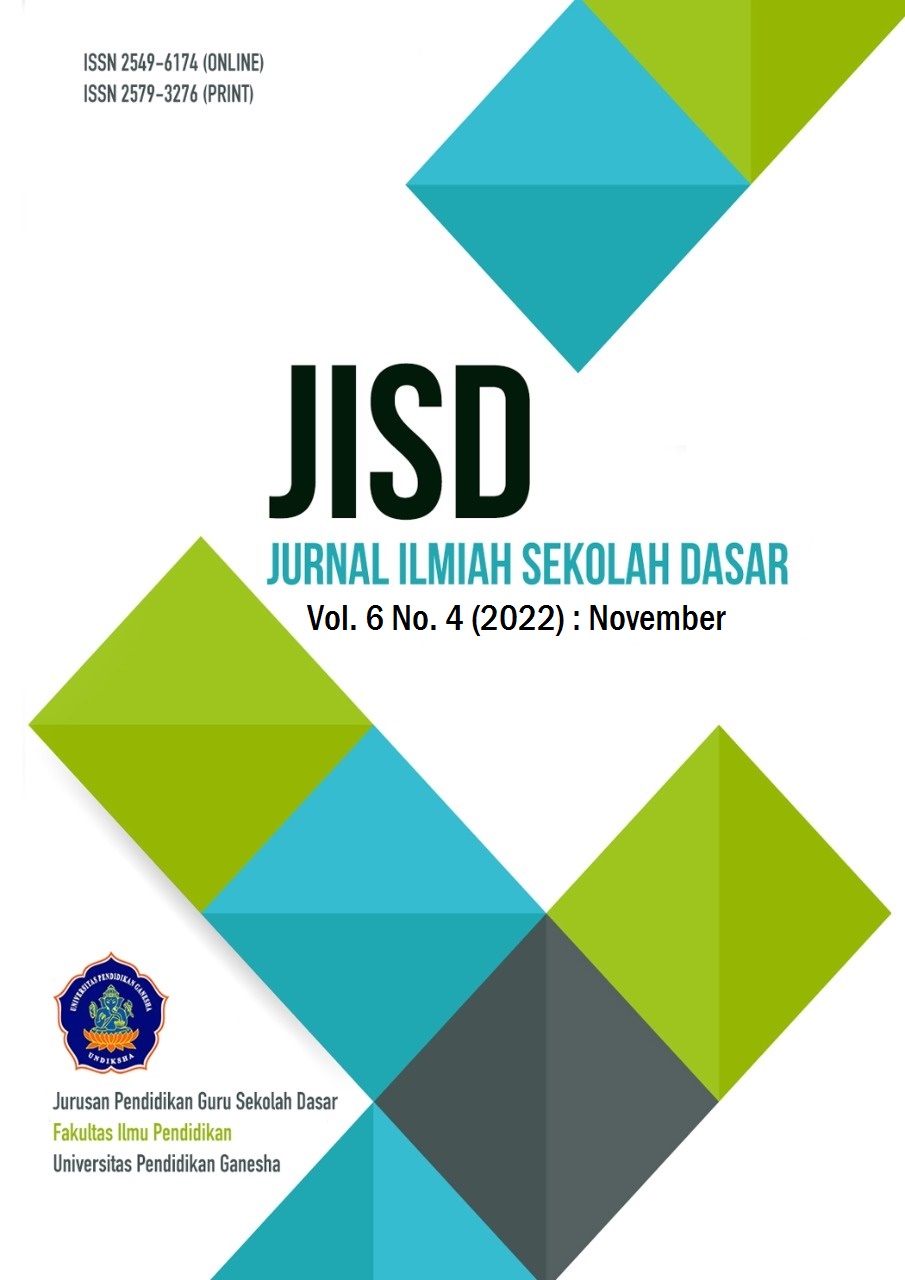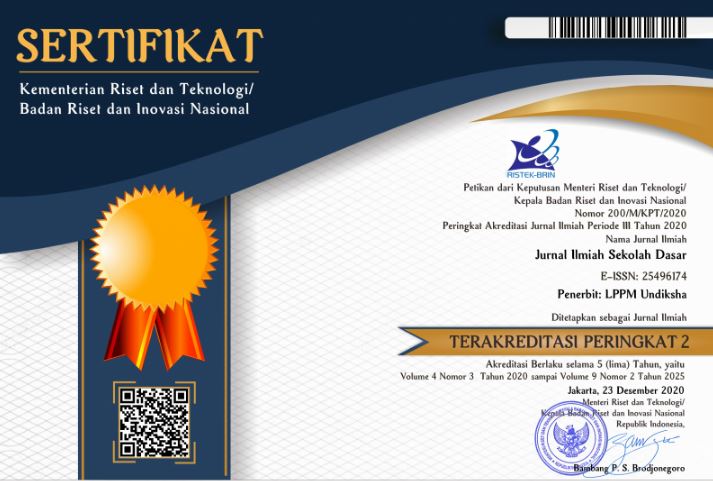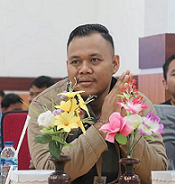The Multiliteration Learning Model on Narrative Writing Skills in Elementary School
DOI:
https://doi.org/10.23887/jisd.v6i4.53983Keywords:
Multiliteracy learning model, narrative writing skills, fifth gradeAbstract
Most students experienced low learning outcomes in learning to write narrative essays in learning Indonesian. It is because the model used by the teacher is still conventional. Learning activities are still teacher-centered, so student creativity needs to develop optimally. Therefore, a learning model is needed that can overcome students' problems in writing narrative essays. This study aims to analyze the effect of the multiliteracy learning model on narrative writing skills in grade V elementary school. This research is quantitative with the type of experimental research in the form of a pre-experimental one-group pretest-posttest design. The sample in this study was 27 students. The sampling technique uses simple random sampling. Observation, tests, and documentation carry out data collection techniques. Data were analyzed using descriptive and inferential statistical analysis with the help of the SPSS version 20 computer program. The results of this study indicate that the teacher's ability to apply the multiliteracy learning model means that it is well implemented. The learning outcomes of students' narrative writing skills in class VB, so the results of this study indicate an influence of the multiliteracy learning model on narrative writing skills in class V elementary school students. From the analysis results, the multiliteracy learning model has proven to affect narrative writing skills.
References
Abdel Latif, M. M. M. (2022). EFL teachers’ critical literacy instructional perspectives and practices: The case of the Egyptian university context. Teaching and Teacher Education, 115. https://doi.org/10.1016/J.TATE.2022.103733. DOI: https://doi.org/10.1016/j.tate.2022.103733
Abidin, Y. (2018). Pembelajaran Multiliterasi: Sebuah Jawaban atas Tantangan Pendidikan Abad Ke-21 dalam Konteks Keindonesiaan. Refika Aditama.
Abidin, Y., Mulyati, T., & Yunansah, H. (2015). Pembelajaran Literasi Dalam Konteks Pendidikan Multiliterasi, Integratif, dan Berdiferensiasi. Rizki Press.
Abidin, Y., Mulyati, T., & Yunansah, H. (2017). Developing Literacy Learning Model Based On Multi Literacy, Integrated, And Differentiated Concept At Primary School. Jurnal Cakrawala Pendidikan, 36(2), 156–166. https://doi.org/10.21831/cp.v36i2.13283. DOI: https://doi.org/10.21831/cp.v36i2.13283
Albrecht, J. R., & Karabenick, S. A. (2018). Relevance for Learning and Motivation in Education. In Journal of Experimental Education. https://doi.org/10.1080/00220973.2017.1380593. DOI: https://doi.org/10.1080/00220973.2017.1380593
Astutik, W. B., & Yuwana, S. (2021). Development of Non-Fiction Text Digital Learning Media in Narrative Writing Skills for Fourth Grade Elementary School Students. IJORER: International Journal of Recent Educational Research, 2(3), 275–292. https://doi.org/10.46245/ijorer.v2i3.99. DOI: https://doi.org/10.46245/ijorer.v2i3.99
Ayuningsih, H., & Zulaeha, I. (2019). The Effectiveness of Learning Using Short Story Writing Multiliteracy Model with Public Service Advertising Media Based on The Learning Types of Senior High School Students. Seloka: Jurnal Pendidikan Bahasa Dan Sastra Indonesia, 8(3), 70–77. https://doi.org/10.15294/SELOKA.V8I3.35637.
Bulqini, A., Puspodari, P., Arfanda, P. E., Suroto, S., & Mutohir, T. C. (2021). Physical Literacy in Physical Education Curriculum. ACTIVE: Journal of Physical Education, Sport, Health and Recreation, 10(2), 55–60. https://doi.org/10.15294/active.v10i2.47008. DOI: https://doi.org/10.15294/active.v10i2.47008
Cahyono, B. Y., & Rahayu, T. (2020). Efl students’ motivation in writing, writing proficiency, and gender. Teflin Journal, 31(2), 162–180. https://doi.org/10.15639/teflinjournal.v31i2/162-180. DOI: https://doi.org/10.15639/teflinjournal.v31i2/162-180
Fareed, M., Ashraf, A., & Bilal, M. (2016). ESL learners’ writing skills: Problems, factors and suggestions. Journal of Education and Social Sciences, 8(2), 81–92. https://geistscience.com/JESS/issue2-16/Article1/JESS1604201.pdf.
Febriyanto, B., & Yanto, A. (2019). The Effectiveness of Photo Story in Multiliteracies Learning Towards Narrative Writing Skills of Fifth Grade Elementary School Students. Al Ibtida: Jurnal Pendidikan Guru MI, 6(2), 191–203. https://doi.org/10.24235/al.ibtida.snj.v6i2.4943. DOI: https://doi.org/10.24235/al.ibtida.snj.v6i2.4943
Forey, G., & Cheung, L. M. E. (2019). The benefits of explicit teaching of language for curriculum learning in the physical education classroom. English for Specific Purposes, 54, 91–109. https://doi.org/10.1016/j.esp.2019.01.001. DOI: https://doi.org/10.1016/j.esp.2019.01.001
Furwana, D., & Syam, A. T. (2019). Improving Students’writing Skill On Descriptive Text By Estafet Strategy Of The Eleventh Year Students Of Sma 4 Palopo. IDEAS: Journal on English Language Teaching and Learning, Linguistics and Literature, 7(1). https://doi.org/10.24256/ideas.v7i1.722. DOI: https://doi.org/10.24256/ideas.v7i1.722
Ginanjar, A. Y., & Widayanti, W. (2019). Penerapan model pembelajaran multiliterasi untuk meningkatkan kemampuan literasi matematis siswa di SD/MI. Primary : Jurnal Keilmuan Dan Kependidikan Dasar, 10(2), 117. https://doi.org/10.32678/primary.v10i02.1283. DOI: https://doi.org/10.32678/primary.v10i02.1283
Hermanto, B. (2020). Perekayasaan sistem pendidikan nasional untuk mencerdaskan kehidupan bangsa. FOUNDASIA, 11(2). https://doi.org/10.21831/foundasia.v11i2.26933. DOI: https://doi.org/10.21831/foundasia.v11i2.26933
Huy, N. T. (2015). Problems affecting learning writing skill of grade 11 at Thong Linh high school. Asian Journal of Educational Research, 3(2). https://www.academia.edu/download/40668008/PROBLEMS-AFFECTING-LEARNING-WRITING-SKILL-OF-GRADE-11.pdf.
Inggriyani, F., & Fazriyah, N. (2017). The Influence of Critical Thinking on Narrative Writing Ability of Fifth Grade Students in Elementary Schools. Journal of Elementary School Education, 3(2), 105–116. https://doi.org/10.30870/jpsd.v3i2.2132. DOI: https://doi.org/10.30870/jpsd.v3i2.2132
Jones, J. M., & Lee, L. H. (2021). Multicultural Competency Building: a Multi-year Study of Trainee Self-Perceptions of Cultural Competence. Contemporary School Psychology, 25(3), 288–298. https://doi.org/10.1007/s40688-020-00339-0. DOI: https://doi.org/10.1007/s40688-020-00339-0
Martavia, R., Thahar, H., & Asri, Y. (2016). Relationship between reading interest and expository narrative writing skills for class VII students of SMP Negeri 11 Padang. Indonesian Language and Literature Education, 5(2), 363–369. https://doi.org/10.24036/10003-019883.
Nabhan, S. (2019). Bringing multiliteracies into process writing approach in ELT classroom: Implementation and reflection. EduLite: Journal of English Education, Literature and Culture, 4(2), 156–170. https://doi.org/10.30659/e.4.2.156-170. DOI: https://doi.org/10.30659/e.4.2.156-170
Nafi’a, M. Z. I., Kuswandi, D., & Wedi, A. (2021). Development of Tringo Based Multiliteracy Learning Model Design as an Effort to Improve Student Writing Skills. In International Conference on Information Technology and Education (ICITE 2021), 172–176. https://doi.org/10.2991/assehr.k.211210.029. DOI: https://doi.org/10.2991/assehr.k.211210.029
Nappi, J. S. (2017). The Impact of Teacher Efficacy and Beliefs on Writing Instruction. International Journal for Professional Educators, 84(1), 17. https://www.dkg.is/static/files/skjol_landsamband/bulletin_grein_jona.pdf#page=17.
Nopilda, L., & Kristiawan, M. (2018). Gerakan Literasi Sekolah Berbasis Pembelajaran Multiliterasi Sebuah Paradigma Pendidikan Abad Ke- 21. JMKSP (Jurnal Manajemen, Kepemimpinan, Dan Supervisi Pendidikan), 3(2). https://doi.org/10.31851/jmksp.v3i2.1862. DOI: https://doi.org/10.31851/jmksp.v3i2.1862
Nugraha, A., Zulela, M., & Bintoro, T. (2018). Relationship between Interest in Reading and Ability to Understand Discourse with Narrative Writing Skills. Indonesian Journal of Primary Education, 2(1), 19–29. https://doi.org/10.17509/ijpe.v2i1.11647. DOI: https://doi.org/10.17509/ijpe.v2i1.11647
Pratidhina, E. (2020). Education 4.0: Pergeseran pendidikan sebagai konsekuensi revolusi industri 4.0. Humanika, 20(1). https://doi.org/10.21831/hum.v20i1.29290. DOI: https://doi.org/10.21831/hum.v20i1.29290
Rahman, M. A., Melliyani, M., Handrianto, C., Erma, E., & Rasool, S. (2022). Prospect and promise in integrating multiliteracy pedagogy in the english language classroom in indonesia. Eternal (English, Teaching, Learning, and Research Journal), 8(1), 34–52. https://doi.org/10.24252/Eternal.V81.2022.A3. DOI: https://doi.org/10.24252/Eternal.V81.2022.A3
Ratnasari, D., Sukarmin, S., & Radiyono, Y. (2017). Implementasi Pendekatan Konstruktivisme melalui Model Pembelajaran CLIS (Children Learning In Science) dan Pengaruhnya terhadap Aktivitas Belajar dan Kemampuan Kognitif Siswa. Jurnal Penelitian & Pengembangan Pendidikan Fisika, 3(1), 111. https://doi.org/10.21009/1.03115. DOI: https://doi.org/10.21009/1.03115
Sadiku, L. M. (2015). The Importance of Four Skills Reading, Speaking, Writing, Listening in a Lesson Hour. European Journal of Language and Literature, 1(1), 29. https://doi.org/10.26417/ejls.v1i1.p29-31. DOI: https://doi.org/10.26417/ejls.v1i1.p29-31
Sharma, C., & Puri, S. R. (2020). The importance of four skills in English education. The Genesis, 7(4), 33–36. https://doi.org/10.47211/tg.2020.v07i04.007. DOI: https://doi.org/10.47211/tg.2020.v07iws01.003
Star, J. R., Chen, J. A., Taylor, M. W., Durkin, K., Dede, C., & Chao, T. (2014). Studying technology-based strategies for enhancing motivation in mathematics. International Journal of STEM Education, 1(1), 2. https://doi.org/10.1186/2196-7822-1-7. DOI: https://doi.org/10.1186/2196-7822-1-7
Sudirman, S. A., Nurmandi, A., & Bashori, K. (2020). English Writing Skills Through Perception of Siri’Cultural Values: Optimism, Social Support, And Academic Self-Efficacy. Jurnal Cakrawala Pendidikan, 39(2), 242–256. https://doi.org/10.21831/cp.v39i2.26118. DOI: https://doi.org/10.21831/cp.v39i2.26118
Tuna, ÿzlem K., & Razı, S. (2016). Integrating Culture into ELT Classes: What, Why, and How? Procedia - Social and Behavioral Sciences, 232, 41–48. https://doi.org/10.1016/j.sbspro.2016.10.009. DOI: https://doi.org/10.1016/j.sbspro.2016.10.009
Wicaksono, A. G., & Sayekti, I. C. (2020). Bagaimana perbandingan kurikulum 2013 dengan kurikulum Australia pada mata pelajaran IPA? Natural: Jurnal Ilmiah Pendidikan IPA, 7(1), 21. https://doi.org/10.30738/natural.v7i1.8117. DOI: https://doi.org/10.30738/natural.v7i1.8117
Xiao, Y., Surasin, J., & Prabjandee, D. (2020). Development of a Training Module to Improve Initial ELT Proficiency Among Student-Teachers in Multi-Ethnic Community Schools. Journal of Language and Linguistic Studies, 16(1), 366–389. https://doi.org/10.17263/JLLS.712849. DOI: https://doi.org/10.17263/jlls.712849
Downloads
Published
How to Cite
Issue
Section
License
Copyright (c) 2022 Rayen Septi Arwita, Jusmawati, Satriawati, Waddi Fatimah, Eka Fitriana H. S.

This work is licensed under a Creative Commons Attribution-ShareAlike 4.0 International License.
Authors who publish with the Journal Ilmiah Sekolah Dasar agree to the following terms:
- Authors retain copyright and grant the journal the right of first publication with the work simultaneously licensed under a Creative Commons Attribution License (CC BY-SA 4.0) that allows others to share the work with an acknowledgment of the work's authorship and initial publication in this journal.
- Authors are able to enter into separate, additional contractual arrangements for the non-exclusive distribution of the journal's published version of the work (e.g., post it to an institutional repository or publish it in a book), with an acknowledgment of its initial publication in this journal.
- Authors are permitted and encouraged to post their work online (e.g., in institutional repositories or on their website) prior to and during the submission process, as it can lead to productive exchanges, as well as earlier and greater citation of published work. (See The Effect of Open Access)










